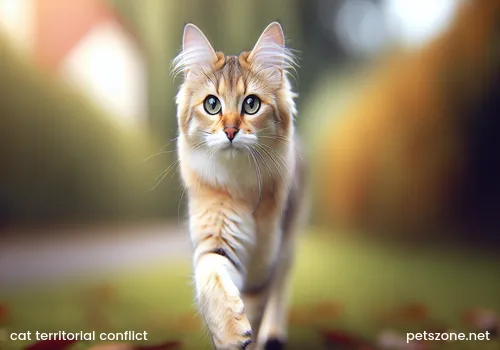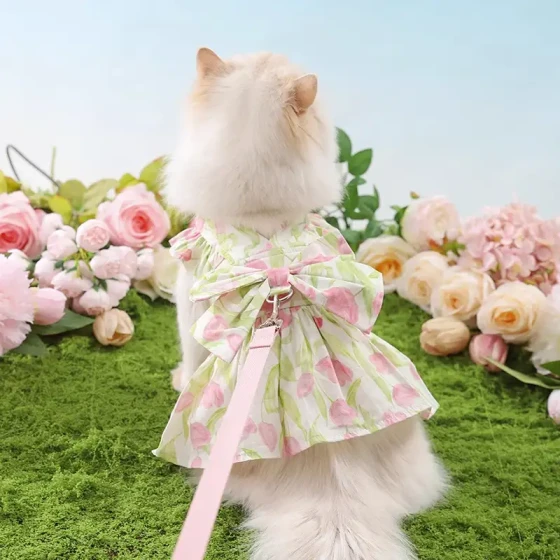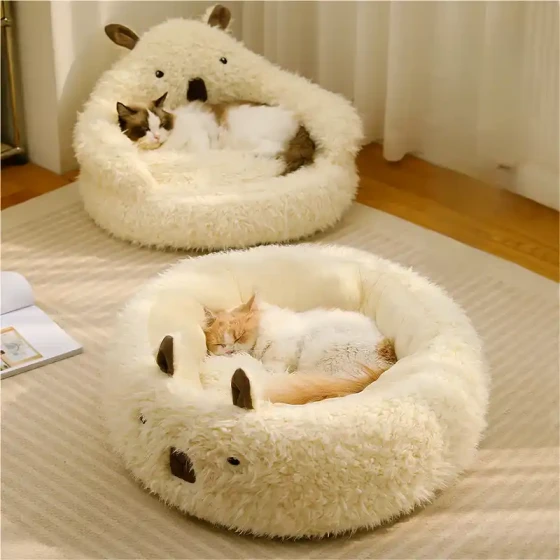Old Cat Rides on New Cat Biting Neck_How to Solve Cat Territorial Conflict Issues
Cats are humans’ “little masters,” and their behavior often leaves people puzzled. Especially when a new member joins the household, many cat owners are bewildered when the old cat exhibits behaviors like “riding on the new cat and biting its neck,” which appear aggressive but are actually complex. Don’t worry, when an old cat rides on a new cat and bites its neck, it is mostly a manifestation of intertwined factors such as territorial awareness, status establishment, play, or mating, rather than simple malicious aggression. The key to resolving such feline territorial conflicts lies in understanding cats' natural instincts and adopting scientific, gradual isolation and reintroduction methods, along with providing sufficient resources and a rich environment to help them resolve conflicts and live peacefully. This will make a multi-cat household truly a harmonious “cat paradise.”

Cat "Palace Intrigue": Why Do They Ride and Bite the Neck?
When you see your old cat riding on the new cat and biting its neck, you might instantly get nervous, thinking the cats are about to fight seriously. However, this behavior in the cat world has far more complex meanings than it appears on the surface, and it isn’t always “full of malice.” It may be driven by multiple natural instincts.
1. Territorial and Status Declaration: Who Is the "Big Boss"?
Cats are naturally extremely territorial animals, viewing every corner of the home as their “private property.” When a new cat enters this “private territory,” the old cat may feel its sovereignty is threatened, triggering strong vigilance. At this time, riding on the new cat and lightly biting its neck is a typical “show of force,” aiming to establish itself as the “boss” of the group, telling the newcomer: “I’m in charge here!” This bite usually doesn’t break the skin but conveys the message “I am stronger than you.” It’s like masters sparring in martial arts novels — just enough to intimidate opponents without serious harm.
2. “Dominant CEO” Courtship Behavior: Male Cat’s Way of “Loving”
If the old cat is an unneutered male and the new cat is a female (especially in heat), this neck-biting behavior is likely the male cat’s courtship ritual. During mating, male cats bite the back of the female's neck to hold her and assert dominance. Although this behavior seems rough to humans, it is a natural reproductive pattern among cats. If your cat is not yet neutered and displays similar behavior, it may be a sign to consider neutering.
3. Play and Hunting Instinct: A “House Play” Game?
Sometimes, cats ride on each other and bite the neck simply as part of play or hunting practice. Especially young cats enjoy pouncing, biting, and scratching to simulate hunting, which is a healthy way to release energy and exercise their bodies. If the bitten cat shows no obvious distress (such as screaming, hissing, fluffed fur), does not try to run away or hide, but actively responds, this is likely a “cat-style wrestling match” as part of their social interaction. Of course, play can occasionally get too rough, and if the bite is too strong or the bitten cat feels discomfort, the owner needs to intervene promptly.
4. Stress and Discomfort: “Abnormal” Behavior Under Psychological Pressure
Besides the above common reasons, cats’ aggressive behavior may also stem from stress reactions or physical discomfort. New environments, unfamiliar odors, changes in living habits (such as moving, new family members, even household noise) can cause cats to feel anxious and uneasy. When cats are under prolonged stress, they may use aggression to vent emotions and show symptoms like inappropriate urination, excessive grooming, hiding, or loss of appetite. If your old cat suddenly shows this aggressive behavior towards the new cat along with other stress symptoms, it’s important to assess whether excessive psychological pressure is the cause.
Breaking Down the “Minefield”: How to Resolve Cat Territorial Conflicts?
Having understood the reasons for cats riding on and biting each other’s necks, the next key question is how to effectively resolve territorial disputes and turn new and old cats from foes into friends or even “good siblings.” This requires great patience and scientific methods from the owner; avoid “head-on collisions” right away.
1. Isolation and Gradual Introduction: Steady and Solid is the Way
“More haste, less speed” is the golden rule for introducing new cats. Never let old and new cats “free play” immediately, as this can easily cause intense conflicts and leave lasting negative impressions. The correct approach is strict isolation and gradual introduction:
- Isolation setup, safety first: Prepare a separate room as a “safe house” for the new cat, equipped with food, water, litter box, and a comfortable bed. Ensure the old cat cannot enter this area, allowing the new cat to adapt to the new home in a completely threat-free environment and build trust in the new environment.
- Scent introduction, getting familiar with each other's smell first: Cats recognize each other by scent. While fully isolated, exchange items carrying each cat’s scent to help them get to know each other. For example, use a clean cloth to lightly rub the cheeks and chin of both cats (areas rich in pheromones), then swap the cloths for each to smell, rewarding them with treats. You can also exchange their beds, blankets, or other objects to familiarize each cat with the other’s scent within their safe zones. This phase usually takes 2-3 weeks or longer until they show neutral or positive responses to each other’s scent.
- Visual contact, separated but in sight: Once they adapt well to each other's scent, try “watching the view through curtains” — allow them to see each other through physical barriers (like glass doors, safety gates, or slightly opened doors) but not interact directly. Feed them simultaneously on either side of the door so they associate each other’s presence with positive experiences. Observe their reactions, and if you notice hissing, growling, or other negative signs, revert to the previous step immediately.
- Short supervised interactions, step by step: When visual contact is successful, try short direct interactions under supervision. Start with just a few minutes and gradually increase. Always stay present during interactions, prepared with toys and treats to encourage positive engagement. If conflict occurs, separate them gently but quickly (for example, use a cardboard barrier or create a loud noise; never use hands to pull apart).
2. Adequate Resources and Environmental Enrichment: Avoid “Territory Battles”
Resource scarcity is a common cause of multi-cat household conflicts. To prevent fights over food, water, litter boxes, scratching posts, beds, etc., owners must ensure ample resources:
- Sufficient litter boxes: The rule of thumb is “number of cats + 1.” For instance, for two cats, prepare three litter boxes placed in different areas to give each cat its “own bathroom,” avoiding conflicts over toilets.
- Separate food and water bowls: Each cat should have its own bowls located in different spots to maintain some distance and reduce feeding stress.
- Multi-level activity spaces: Cats love vertical spaces. Provide cat trees, jump platforms, high shelves, etc., so each cat can have its own “high ground” and “private space,” reducing territorial disputes. It’s like offering them a multilevel villa rather than a crowded flat floor.
- Toys and scratching posts: Provide plenty of toys and scratching posts to meet cats' needs for claw sharpening, play, and energy release.
3. Emotional Management and Behavioral Aids: Gentle “Divine Assistance”
Besides adjusting the physical environment, managing cats’ emotions and providing behavioral support are crucial:
- Pheromone diffusers: Brands like Feliway produce cat calming pheromone diffusers that mimic the “happy pheromones” cats release from their faces, helping cats relax and reduce anxiety and conflicts. Plug it into outlets in areas where cats spend most time to create a more comfortable, secure atmosphere.
- Fair treatment, no favoritism: Owners should maintain “a fair hand,” giving equal love, companionship, and playtime to new and old cats. Avoid excessive favoritism to prevent jealousy and resentment.
- Positive reinforcement: When cats show positive interactions (like sniffing each other, grooming, or coexisting peacefully), immediately reward them with treats, petting, or verbal praise. This strengthens friendly behavior and helps them associate each other with pleasant experiences.
- Patience and observation: Cats’ adaptation varies individually and may take weeks, months, or longer. Owners need to be patient, closely observe body language and behavioral changes, and adjust strategies accordingly. If aggression or stress symptoms persist or conditions fail to improve, seek professional pet behaviorists or veterinarians’ assistance.
Frequently Asked Questions
- Q1: Is the old cat riding the new cat and biting its neck considered bullying?
A1: Not necessarily. This behavior could be a combination of factors including territorial and status declaration, play, courtship, or rarely, stress response. If the bitten cat shows no obvious pain, resistance, or avoidance, it may be normal social or play behavior. However, if accompanied by hissing, growling, puffed fur, or vicious biting, it could be genuine aggression. - Q2: How to tell if cats are playing or fighting?
A2: Observe their body language and sounds. During play, cats move lightly, rhythmically, with controlled biting strength. The “attacked” cat may actively respond or not show fear. Sounds are usually excited, not screams or hisses. In real fights, cats bare sharp teeth and claws, bite hard possibly locking throats or kicking with hind legs, make screaming, hissing, or growling noises, are emotionally agitated, and want to continue fighting even after separation. - Q3: Is neutering necessary in multi-cat households?
A3: Neutering is recommended, especially for sexually mature, unneutered male cats, which are prone to frequent fighting over territory and mates and may exhibit marking behaviors. Neutering effectively reduces hormones, aggression, and territorial behaviors, helping cats live more peacefully. - Q4: If a cat is not eating, drinking, and hiding, is it stressed?
A4: Yes, this is a common sign of stress. Stress can also cause vomiting, diarrhea, excessive grooming, inappropriate elimination, rapid breathing, dilated pupils, and flattened ears. If these occur, identify and remove stressors quickly and provide a safe, quiet space. - Q5: Is socialization training important? Can adult cats socialize?
A5: Very important. Socialization helps cats learn how to interact with conspecifics and humans and adapt to changes. The critical socialization period is 2-7 weeks of age, aiding kittens to develop confidence and friendly behavior. Adult cats can also be socialized, though more slowly, through scientific positive guidance and patience, improving behavior and relations with people and pets.
Conclusion
When an old cat rides on a new cat and bites its neck, it may look like playful scuffles but actually involves complex natural instincts and behavioral patterns. Responsible owners should not only interpret cats’ “subtext” but also actively apply scientific methods such as gradual isolation and introduction, ample resource provision, and emotional support to help resolve conflicts and promote harmony. Cat-keeping is a practice of patience and understanding; with more comprehension and patience, your household “cat masters” will leave behind the “palace intrigues” and create a warm “cat family” scene.
References
- CATRAWS. How to Let New and Old Cats Live Peacefully? Four-Step Isolation and Introduction Perfected. (2023-01-13).
- OneDegree HK. Cat Fights | What to Do When Two Cats Don’t Get Along? How to Solve? Understanding Causes and Solutions. (2021-09-10).
- Tencent News. On Cat Stress, Detailed Analysis. (2023-07-13).
- Cat Garden. 12 Types of Cat Aggression Explained! (2022-08-09).
- Feliway - FELIWAY. FAQ.
- Cat Garden. What To Do When Cats Are Stressed? 6 Common Symptoms + 3 Stress Relief Tips. (2025-03-07).
- Monster Tribe. What to Do When Cats Fight? Top 5 Rules for Multi-Cat Families! (2021-11-26).
- Douban. What To Do If Cats Are Aggressive? — Cat Behavior Issues and Solutions (Part 3). (2019-04-30).
- NetEase. On Cat “Stress Response,” Don’t Ignore It! (2023-06-19).
- Pet Planet. How to Improve Cat Aggression Toward Owners? 7 Types of Aggressive Behavior and Solutions. (2025-05-21).
- What Is Worth Buying. How to Help Cats Accept New Partners? How Two Cats Can Live Peacefully. (2022-05-10).
- Cat Talk Society. Teaching You to Judge Cat Aggression Issues. (2023-02-03).
- Pets. How to Prevent Fighting in Multi-Cat Families. (2025-04-11).
- NetEase. Excessive Stress Can Be Fatal, What to Do When Cats Show Stress? (2020-03-23).
- Orange Cat. Cat Behavior: How to Help New Cats Get Along With Old Masters?
- Furry Garden. [Cat Fights] What to Do If Cats Don’t Get Along? 6 Practical Tips to Resolve Conflicts and Help Them Coexist Peacefully. (2023-01-26).
- NetEase. Causes of Cat Aggression, Understanding These Helps Resolve Crises. (2022-10-02).
- Sina. What to Do When Cats Are Stressed? It Could Be Life-Threatening! (2021-06-10).
- How Much Do You Know About Pets. Reduce Stress Through Environmental Enrichment, Raise Happy Cats! (2021-04-16).
- NetEase. Common Causes of Conflicts Between Cats and the Need for Intervention. (2025-02-08).
- Baidu Knows. Old Cat Riding and Biting New Cat’s Neck.
- NetEase Original. What Should Owners Do When Cats Fight? (2015-07-03).
- Douban. [Science Popularization] Several Hard-To-Spot Conflicts in Multi-Cat Families - Group Discussion. (2024-08-12).
- Furry Garden. Why Do Cats Fight? Director Mao Summarizes Common Causes of Cat Fights; If You Want to Welcome a New Cat Family Member, Learn This Now! (2023-01-26).
- NetEase. Socialization Training is Key to Making Cats Affectionate. (2019-11-18).
- Tencent News. How to Better Socialize Kittens? Secrets to Raise Well-Tempered Kittens. (2024-09-02).
- Official Feliway Website - FELIWAY for Cats. Did You Know? Cats Communicate by Releasing a Natural Chemical Signal Called “Happy Message” Into the Air.
- Douban. What You Need to Know About Introducing New Cats to Existing Cats (Reprint). (2016-11-08).
- Wang Miao Planet. How Long Does New and Old Cat Adjustment Take? Direct Meetings May Cause Fights? Essential Guide to Peaceful Coexistence with a Second Cat.
- Produits-Veto.com. Feliway Optimum - Diffuser and Recharge - Stress and Conflict - CEVA.
- PChome 24h Shopping. Feliway Classic Calming Diffuser Refill for Cats.
- NetEase. What to Do When Harajuku Cats Don’t Accept New Cats? Step-by-step Methods to Solve the Problem. (2021-01-05).
- Understanding the importance of cats.
- Considerate Fur Baby. [Zero Fear Hands-On Training™] What Is Cat Socialization? Nine Practical Exercises Especially Useful for Human-Cat Life. (2023-09-15).
- Slowly Understanding Cats. What to Prepare Before Raising a New Cat? Complete 5-step New and Old Cat Isolation Introduction Teaching. (2023-04-29).
- Tencent News. Can Cats Smell Another Cat on Your Body? (2023-11-08).
- Royal Canin. Teaching Kittens Socialization.
- PChome 24h Shopping. FELIWAY French Multi-Cat Friend Refill Bottle.
- Douban. “Real Conflict” or “Just Playing”? How to Judge If Social Relationships Between Cats Are Healthy? (2025-05-15).
- China Digital Science Museum. What Exactly Is the Smell on a Cat’s Body? (2017-04-25).
- Reddit. Dog Attacked Cat Over Food Guarding: r/reactivedogs. (2024-09-21).
- Love Fur Babies PETSi17. Why Do Cats Bite Each Other’s Neck? Unveiling the Interesting Behavioral Reasons. (2024-12-10).
- Cat Protection Society of Victoria. Are You Considering Giving Up Your Cat?


-560x560.webp)
-560x560.webp)

